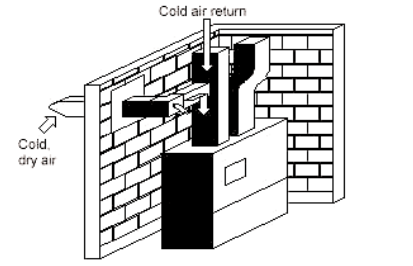Homeowners who have highly energy-efficient windows may notice condensation forming on the outside under certain weather conditions. “Why is my bedroom window covered in moisture early in the morning? This question is often asked by homeowners who have highly energy-efficient windows. This condition usually occurs in late summer and early fall when the night time temperature drops several degrees. The moisture on the outside of the window is condensation. It will soon evaporate when outside temperature rises. As we know, condensation happens on cold surfaces. During the night, if the outside temperature drops below the dew point then condensation forms. The fact that the condensation is forming on the windows means that very little heat from inside the house is escaping through the windows. That’s a good thing and proof that you have energy-efficient windows.
CONDENSATION
Condensation is the passing of a substance from a lighter to a denser physical state. In this instance, water passes from a gaseous (vapour) state to the denser liquid one. Because it is caused by too much humidity, condensation is also the symptom of a more serious problem – excessive moisture at work in your home’s atmosphere.
WHY DOES CONDENSATION OCCUR?
Problems arise because air can hold only a limited amount of water vapour, varying with the temperature. Condensation is related to two conditions always present in the atmosphere inside your home. It is likely to form whenever there is an improper balance between:
Relative Humidity
A ratio between the water vapour in the air compared to the maximum amount that air can hold at a given temperature. For example, 50% means the air is carrying 1/2 of the total water vapour it is capable of holding at that temperature.
Temperature
A particular temperature where the relative humidity becomes 100%, called the “dew point” (see chart). At the dew point, the air is saturated with moisture and begins to lose it in the form of condensation.
Relative Humidity
Dew Point (Celsius)
20%
30%
40%
50%
-4˚
2˚
6˚
10˚
* Note: A new home has significant quantities of moisture because of the water used in various areas of construction (700 gallons of water are used in plastering alone for a sixroom house). This will be eliminated after a period of time.
WHY DOES CONDENSATION OCCUR?
In practice, condensation will occur first over the lower part of the window because glass surface temperatures are not uniform, being lower at the bottom than at the top.
Sources of Mouisture
The humidity level in a house during the winter will depend on both the moisture added to the air through family living habits (see chart) and the rate at which this moisture is removed by ventilation or condensation.
Quantity of Moisture Added to the Air Through Normal Household Activities
Activity (for a family of four)
Moisture in Litres each week
Cooking (3 meals per day for 1 week)
Dishwashing (3 times per day for 1 week)
Bathing (.2 litres per shower) (.05 litres per bath)
Clothes washing
Clothes drying indoors, or using an unvented dryer
Floor mopping (per 9.3m)
Occupants
Total Moisture Production per Week
6.3
3.2
2.4
1.8
10
1.3
38
63
In addition to the above sources of humidity, such things as gas appliances, dryers vented inside, plants (which put out almost as much water as they receive), pets, humidifiers, damp basements, etc., all increase the humidity level in a home.
SOLUTION AND FACTS ABOUT HUMIDITY
Solutions
- Turn off all humidifiers, particularly in homes with forced-air heating.
- Move plants away from windows (where water vapour will be released directly onto glass).
- Vent the clothes dryer and gas appliances outside.
- Do not dry firewood indoors.
- Ensure kitchens and bathrooms are well ventilated by windows or exhaust fans.
- Ensure that basement walls are kept as dry as possible since they will act as humidifiers when wet.
- A de-humidifier may have to be installed (Note: a de-humidifier alone cannot eliminate the problem).
- Do not cover windows with heavy curtains since this will restrict air flow over glass.
- Produce less moisture inside the house.
Facts
- Unless indoor humidities are kept below 10%, it is impossible to avoid some condensation.
- Lower outside temperatures require lower inside humidity levels (see chart).
- Electrically heated homes are difficult to rectify because there is very little movement of air.
- Ventilation is generally the most effective means available to reduce humidity and can be done by opening windows, operating exhaust fans and/or installing a ventilator from outside into the cold air return plenum of a forced air heating system
(see following diagram).
Reducing Humidity Levels With a Forced-Air Furnace

Sources for Information
- Ontario Ministry of Municipal Affairs and Housing
- Canadian General Standards Board
- National Research Council (Division of Building Research)
- Rolscreen Company (Pella Windows)
For more Information Please visit Natural Resources Canada or Download PDF.
